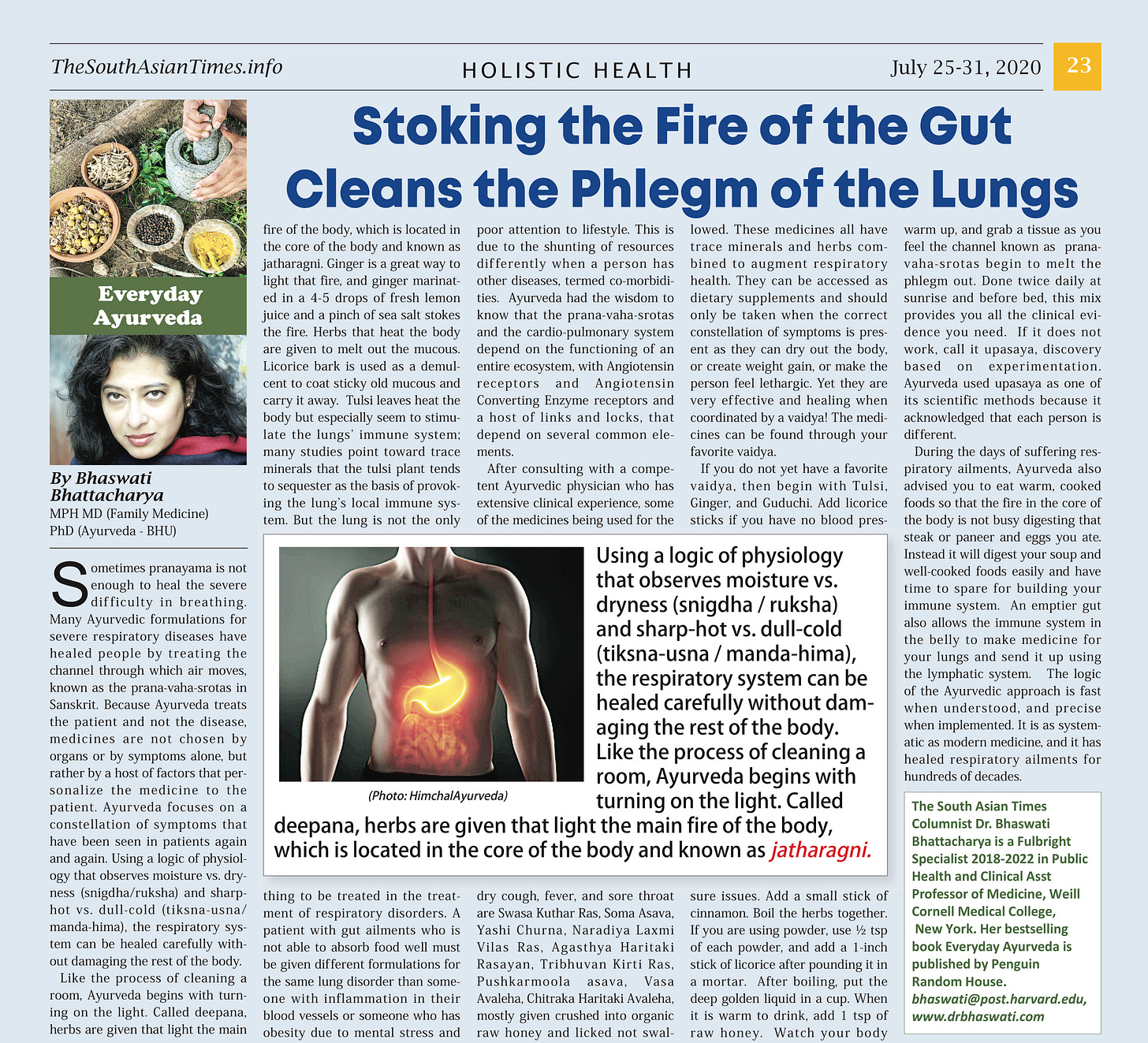Stoking the Fire of the Gut
Using the logic of physiology that observes moisture vs. dryness (snigdha/ruksha) and sharp-hot vs. dull-cold (tiksna-usna/ manda-hima), the respiratory system can be healed carefully without damaging the rest of the body.
Like the process of cleaning a room, Ayurveda begins with turning on the light. Called deepana, herbs are given that light the main fire of the body, which is located in the core of the body and known as jatharagni.
Stoking the Fire of the Gut Cleans the Phlegm of the Lungs
Sometimes pranayama is not enough to heal the severe difficulty in breathing. Many Ayurvedic formulations for severe respiratory diseases have healed people by treating the channel through which air moves, known as the prana-vaha-srotas in Sanskrt. Because Ayurveda treats the patient and not the disease, medicines are not chosen by organs or by symptoms alone, but rather by a host of factors that personalize the medicine to the patient. Ayurveda focuses on a constellation of symptoms that have been seen in patients again and again. Using a logic of physiology that observes moisture vs. dryness (snigdha/ruksha) and sharp-hot vs. dull-cold (tiksna-usna/ manda-hima), the respiratory system can be healed carefully without damaging the rest of the body.
Like the process of cleaning a room, Ayurveda begins with turning on the light. Called deepana, herbs are given that light the main fire of the body, which is located in the core of the body and known as jatharagni. Ginger is a great way to light that fire, and ginger marinated in a 4-5 drops of fresh lemon juice and a pinch of sea salt stokes the fire. Herbs that heat the body are given to melt out the mucous. Licorice bark is used as a demulcent to coat sticky old mucous and carry it away. Tulsi leaves heat the body but especially seem to stimulate the lung’s immune system; many studies point toward trace minerals that the tulsi plant tends to sequester as the basis of provoking the lung’s local immune system.
But the lung is not the only thing to be treated in the treatment of respiratory disorders. A patient with gut ailments who is not able to absorb food well must be given different formulations for the same lung disorder than someone with inflammation in their blood vessels or someone who has obesity due to mental stress and poor attention to lifestyle. This is due to the shunting of resources differently when a person has other diseases, termed co-morbidities. Ayurveda had the wisdom to know that the prana-vaha-srotas and the cardio-pulmonary system depend on the functioning of an entire ecosystem, with Angiotensin receptors and Angiotensin Converting Enzyme receptors and a host of links and locks, that depend on several common elements.
After consulting with a competent Ayurvedic physician who has extensive clinical experience, some of the medicines being used for the dry cough, fever, and sore throat are Swasa Kuthar Ras, Soma Asava, Yashi Churna, Naradiya Laxmi Vilas Ras, Agasthya Haritaki Rasayan, Tribhuvan Kirti Ras, Pushkarmoola asava, Vasa Avaleha, Chitraka Haritaki Avaleha, mostly given crushed into organic raw honey and licked not swallowed. These medicines all have trace minerals and herbs combined to augment respiratory health. They can be accessed as dietary supplements and should only be taken when the correct constellation of symptoms are present as they can dry out the body, or create weight gain, or make the person feel lethargic. Yet they are very effective and healing when coordinated by a vaidya! The medicines can be found through your favorite vaidya.
If you do not yet have a favorite vaidya, then begin with Tulsi, Ginger, and Guduchi. Add licorice sticks if you have no blood pressure issues. Add a small stick of cinnamon. Boil the herbs together. If you are using powder, use ½ tsp of each powder, and add a 1-inch stick of licorice after pounding it in a mortar. After boiling, put the deep golden liquid in a cup. When it is warm to drink, add 1 tsp of raw honey. Watch your body warm up, and grab a tissue as you feel the channel known as prana-vaha-srotas begin to melt the phlegm out. Done twice daily at sunrise and before bed, this mix provides you all the clinical evidence you need. If it does not work, call it upasaya, discovery based on experimentation. Ayurveda used upasaya as one of its scientific methods because it acknowledged that each person is different.
During the days of suffering respiratory ailments, Ayurveda also advised you to eat warm, cooked foods so that the fire in the core of the body is not busy digesting that steak or paneer and eggs you ate. Instead it will digest your soup and well-cooked foods easily and have time to spare for building your immune system. An emptier gut also allows the immune system in the belly to make medicine for your lungs and send it up using the lymphatic system. The logic of the Ayurvedic approach is fast when understood, and precise when implemented. It is as systematic as modern medicine, and it has healed respiratory ailments for hundreds of decades.
week18. TheSouthAsianTimes
Obtain the .pdf version of this column by clicking on the image.
Dr. Bhaswati Bhattacharya is a Fulbright Specialist 2018‐2023 in Public Health. She serves as Clinical Asst Professor of Family Medicine in the Department of Medicine at Weill Cornell Medical College in New York, NY.
Her bestselling book Everyday Ayurveda is published by Penguin Random House. To order an autographed copy, write to bhaswati@post.harvard.edu.
www.drbhaswati.com





